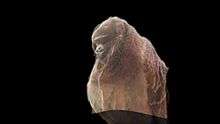Morphing

Morphing is a special effect in motion pictures and animations that changes (or morphs) one image or shape into another through a seamless transition. Most often it is used to depict one person turning into another through technological means or as part of a fantasy or surreal sequence. Traditionally such a depiction would be achieved through cross-fading techniques on film. Since the early 1990s, this has been replaced by computer software to create more realistic transitions.
Early examples
Though the 1986 movie The Golden Child implemented very crude morphing effects from animal to human and back, the first movie to employ detailed morphing was Willow, in 1988. A similar process was used a year later in Indiana Jones and the Last Crusade to create Walter Donovan's gruesome demise. Both effects were created by Industrial Light & Magic using grid warping techniques developed by Tom Brigham and Doug Smythe (AMPAS).[1]
In 1985, Godley & Creme created a "morph" effect using analogue cross-fades in the video for "Cry". The cover for Queen's 1989 album The Miracle featured the technique to morph the four band members' faces into one gestalt image. In 1991, morphing appeared notably in the Michael Jackson music video "Black or White" and in the movies Terminator 2: Judgment Day and Star Trek VI: The Undiscovered Country. The first application for personal computers to offer morphing was Gryphon Software Morph on the Macintosh. Other early morphing systems included ImageMaster, MorphPlus and CineMorph, all of which premiered for the Commodore Amiga in 1992. Other programs became widely available within a year, and for a time the effect became common to the point of cliché. For high-end use, Elastic Reality (based on MorphPlus) saw its first feature film use in In The Line of Fire (1993) and was used in Quantum Leap (work performed by the Post Group). At VisionArt Ted Fay used Elastic Reality to morph Odo for Star Trek: Deep Space Nine. Elastic Reality was later purchased by Avid, having already become the de facto system of choice, used in many hundreds of films. The technology behind Elastic Reality earned two Academy Awards in 1996 for Scientific and Technical Achievement going to Garth Dickie and Perry Kivolowitz. The effect is technically called a "spatially warped cross-dissolve". The first social network designed for user-generated morph examples to be posted online was Galleries by Morpheus (morphing software).
In Taiwan, Aderans, a hair loss solutions provider, did a TV commercial featuring a morphing sequence in which people with lush, thick hair morph into one another, reminiscent of the end sequence of the "Black or White" video.
Modern techniques

In the early 1990s computer techniques that often produced more convincing results began to be widely used. These involved distorting one image at the same time that it faded into another through marking corresponding points and vectors on the "before" and "after" images used in the morph. For example, one would morph one face into another by marking key points on the first face, such as the contour of the nose or location of an eye, and mark where these same points existed on the second face. The computer would then distort the first face to have the shape of the second face at the same time that it faded the two faces. To compute the transformation of image coordinates required for the distortion, the algorithm of Beier and Neely can be used.
Later, more sophisticated cross-fading techniques were employed that vignetted different parts of one image to the other gradually instead of transitioning the entire image at once. This style of morphing was perhaps most famously employed in the video that former 10cc members Kevin Godley and Lol Creme (performing as Godley & Creme) produced in 1985 for their song Cry. It comprised a series of black and white close-up shots of faces of many different people that gradually faded from one to the next. In a strict sense, this had little to do with modern-day computer generated morphing effects, since it was merely a dissolve using fully analog equipment.
Present use
Morphing algorithms continue to advance and programs can automatically morph images that correspond closely enough with relatively little instruction from the user. This has led to the use of morphing techniques to create convincing slow-motion effects where none existed in the original film or video footage by morphing between each individual frame using optical flow technology. Morphing has also appeared as a transition technique between one scene and another in television shows, even if the contents of the two images are entirely unrelated. The algorithm in this case attempts to find corresponding points between the images and distort one into the other as they crossfade.
While perhaps less obvious than in the past, morphing is used heavily today. Whereas the effect was initially a novelty, today, morphing effects are most often designed to be seamless and invisible to the eye.
A particular use for morphing effects is modern digital font design. Using morphing technology, called interpolation or multiple master technology, a designer can create an intermediate between two styles, for example generating a semibold font by compromising between a bold and regular style, or extend a trend to create an ultra-light or ultra-bold. The technique is commonly used by font design studios.[2]
Software
- Morpheus
- Nuke
- After Effects
- FantaMorph
- Gryphon Software Morph
- MorphThing
- SilhouetteFX (new algorithms by the above cited Perry Kivolowitz)
- Angelmorph
See also
References
- ↑ AMPAS - Index of Motion Picture Credits - Films
- ↑ Riggs, Tamye. "The Adobe Originals Silver Anniversary Story". Typekit blog. Adobe. Retrieved 2 July 2015.
External links
| Look up morphing in Wiktionary, the free dictionary. |
- Tutorial on morphing using Adobe After Effects
- Morph images on Mac OS X
- Xmorph: A Walkthrough of Morphing
- Morph2d
- javamorph